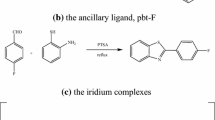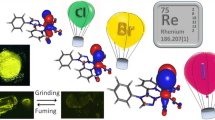Abstract
In this work, a near-infrared (NIR) phosphorescent probe for F− based on a cationic Ir(III) complex [Ir(Bpq)2(quqo)]PF6 (1) with dimesitylboryl (Mes2B) groups on the cyclometalated C∧N ligands (Bpq) and 2-(quinolin-2-yl)quinoxaline (quqo) as N∧N ligand was designed and synthesized. The excited state properties of 1 were investigated in detail using molecular orbital calculations and experimental methods. Upon excitation, complex 1 shows NIR phosphorescent emission around 680 nm. Interestingly, the complex can be excited with long wavelength around 610 nm. Such long-wavelength excitation can reduce the background emission interference and improve the signal-to-noise ratio. Furthermore, the selective binding between boron atom and F− can give rise to the quenching of emission and realize the near-infrared phosphorescent sensing for F−. We wish that the results reported herein will be helpful for the further design of excellent near-infrared phosphorescent probes based on heavy-metal complexes.
Similar content being viewed by others
References
Beer PD, Gale PA. Anion recognition and sensing: The state of the art and future perspectives. Angew Chem Int Ed, 2001, 40: 486–516
Martinez-Manez R, Sancenon F. Fluorogenic and chromogenic chemosensors and reagents for anions. Chem Rev, 2003, 103: 4419–4476
Bowman-James K. Alfred Werner revisited: The coordination chemistry of anions. Acc Chem Res, 2005, 38: 671–678
Amendola V, Esteban-Gómez D, Fabbrizzi L, Licchelli M. What anions do to N-H-containing receptors. Acc Chem Res, 2006, 39: 343–353
Gale PA. Structural and molecular recognition studies with acyclic anion receptors. Acc Chem Res, 2006, 39: 465–475
Cametti M, Rissanen K. Recognition and sensing of fluoride anion. Chem Commun, 2009: 2809–2829
Boiocchi M, Del Boca L, Gómez DE, Fabbrizzi L, Licchelli M, Monzani E. Nature of urea-fluoride interaction: Incipient and definitive proton transfer. J Am Chem Soc, 2004, 126: 16507–16514
Kang SO, VanderVelde D, Powell D, Bowman-James K. Fluoride-facilitated deuterium exchange from DMSO-d 6 to polyamide-based cryptands. J Am Chem Soc, 2004, 126: 12272–12273
Kang SO, Powell D, Day VW, Bowman-James K. Trapped bifluoride. Angew Chem Int Ed, 2006, 45: 1921–1925
Lee MH, Agou T, Kobayashi J, Kawashima T, Gabba FP. Fluoride ion complexation by a cationic borane in aqueous solution. Chem Commun, 2007: 1133–1135
Liu XY, Bai DR, Wang SN. Charge-transfer emission in nonplanar three-coordinate organoboron compounds for fluorescent sensing of fluoride. Angew Chem Int Ed, 2006, 45: 5475–5478
Parab K, Venkatasubbaiah K, Jäkle F. Luminescent triarylborane-functionalized polystyrene: Synthesis, photophysical characterization, and anion-binding studies. J Am Chem Soc, 2006, 128: 12879–12885
Ros-Lis JV, Martínez-Máñez R, Sancenón M, Soto J, Rurack K, Weißshoff H. Signalling mechanisms in anion-responsive push-pull chromophores: The hydrogen-bonding, deprotonation and anionexchange chemistry of functionalized azo dyes. Eur J Org Chem, 2007: 2449–2458
Gale PA, Garcia-Garrido SE, Garric J. Anion receptors based on organic frameworks: Highlights from 2005 and 2006. Chem Soc Rev, 2007
Miyaji H, Sato W, Sessler JL. Naked-eye detection of anions in dichloromethane: Colorimetric anion sensors based on calix[4]pyrrole. Angew Chem Int Ed, 2000, 39: 1777–1780
Schmidtchen FP, Berger M. Artificial organic host molecules for anions. Chem Rev, 1997, 97: 1609–1646
Arnendola V, Bonizzoni M, Esteban-Gomez D, Fabbrizzi L, Licchelli M, Sancenon F, Taglietti A. Some guidelines for the design of anion receptors. Coordin Chem Rev, 2006, 250: 1451–1470
Lin ZH, Ou SJ, Duan CY, Zhang RG, Bai ZP. Naked-eye detection of fluoride ion in water: A remarkably selective easy-to-prepare test paper. Chem Commun, 2006: 624–626
Palacios MA, Nishiyabu R, Marquez M, Anzenbacher P. Supramolecular chemistry approach to the design of a high-resolution sensor array for multianion detection in water. J Am Chem Soc, 2007, 129: 7538–7544
Aydogan A, Coady DJ, Kim SK, Akar A, Bielawski CW, Marquez M, Sessler JL. Poly(methyl methacrylate)s with pendant calixpyrroles and crown ethers: Polymeric extractants for Potassium halides. Angew Chem Int Ed, 2008, 47: 9648–9652
Hu R, Feng JA, Hu DH, Wang SQ, Li SY, Li Y, Yang GQ. A rapid aqueous fluoride ion sensor with dual output modes. Angew Chem Int Ed, 2010, 49: 4915–4918
Kubo Y, Yamamoto M, Ikeda M, Takeuchi M, Shinkai S, Yamaguchi S, Tamao K. A colorimetric and ratiometric fluorescent chemosensor with three emission changes: Fluoride ion sensing by a triarylborane-porphyrin conjugate. Angew Chem Int Ed, 2003, 42: 2036–2040
Liu ZQ, Shi M, Li FY, Fang Q, Chen ZH, Yi T, Huang CH. Highly selective two-photon chemosensors for fluoride derived from organic boranes. Org Lett, 2005, 7: 5481–5484
Yamaguchi S, Akiyama S, Tamao K. Colorimetric fluoride ion sensing by boron-containing pi-electron systems. J Am Chem Soc, 2001, 123: 11372–11375
Patonay G, Antoine MD. Near-infrared fluorogenic labels—New approach to an old problem. Anal Chem, 1991, 63: A321–A326
Fabian J, Nakazumi H, Matsuoka M. Near-infrared absorbing dyes. Chem Rev, 1992, 92: 1197–1226
Hudnall TW, Gabbai FP. Ammonium boranes for the selective complexation of cyanide or fluoride ions in water. J Am Chem Soc, 2007, 129: 11978–11986
You YM, Park SY. A Phosphorescent Ir(III) complex for selective fluoride ion sensing with a high signal-to-noise ratio. Adv Mater, 2008, 20: 3820–3826
Sakuda E, Funahashi A, Kitamura N. Synthesis and spectroscopic properties of platinum(II) terpyridine complexes having an arylborane charge transfer unit. Inorg Chem, 2006, 45: 10670–10677
Zhao Q, Li FY, Huang CH. Phosphorescent chemosensors based on heavy-metal complexes. Chem Soc Rev, 2010, 39: 3007–3030
Zhao Q, Cao TY, Li FY, Li XH, Jing H, Yi T, Huang CH. A highly selective and multisignaling optical-electrochemical sensor for Hg2+ based on a phosphorescent iridium(III) complex. Organometallics, 2007, 26: 2077–2081
Zhao Q, Liu SJ, Li FY, Yi T, Huang CH. Multisignaling detection of Hg2+ based on a phosphorescent iridium(III) complex. Dalton Trans, 2008: 3836–3840
Chen HL, Zhao Q, Wu YB, Li FY, Yang H, Yi T, Huang CH. Selective phosphorescence chemosensor for homocysteine based on an iridium(III) complex. Inorg Chem, 2007, 46: 11075–11081
Zhao Q, Li FY, Liu SJ, Yu MX, Liu ZQ, Yi T, Huang CH. Highly selective phosphorescent chemosensor for fluoride based on an iridium(III) complex containing arylborane units. Inorg Chem, 2008, 47: 9256–9264
Xu WJ, Liu SJ, Zhao XY, Sun S, Cheng S, Ma TC, Sun HB, Zhao Q, Huang W. Cationic iridium(III) complex containing both triarylboron and carbazole moieties as a ratiometric fluoride probe that utilizes a switchable triplet-singlet emission. Chem Eur J, 2010, 16: 7125–7133
Zhao SB, McCormick T, Wang S. Ambient-temperature metal-toligand charge-transfer phosphorescence facilitated by triarylboron: Bnpa and its metal complexes. Inorg Chem, 2007, 46: 10965–10967
Sun Y, Ross N, Zhao SB, Huszarik K, Jia WL, Wang RY, Macartney D, Wang SN. Enhancing electron accepting ability of triarylboron via pi-conjugation with 2,2′-bipy and metal chelation: 5,5′-Bis(BMes(2))-2,2′-bipy and its metal complexes. J Am Chem Soc, 2007, 129: 7510–7512
Lam ST, Zhu NAY, Yam VWW. Synthesis and characterization of luminescent rhenium(I) tricarbonyl diimine complexes with a triarylboron moiety and the study of their fluoride ion-binding properties. Inorg Chem, 2009, 48: 9664–9670
Rao YL, Wang SN. Impact of constitutional isomers of (BMes(2)) phenylpyridine on structure, stability, phosphorescence, and lewis acidity of mononuclear and dinuclear Pt(II) complexes. Inorg Chem, 2009, 48: 7698–7713
Hudson ZM, Zhao SB, Wang RY, Wang SN. Switchable ambient-temperature singlet-triplet dual emission in nonconjugated donoracceptor triarylboron-Pt-II complexes. Chem Eur J, 2009, 15: 6131–6137
Sun Y, Wang SN. Conjugated triarylboryl donor-acceptor systems supported by 2,2′-Bipyridine: Metal chelation impact on intraligand charger transfer emission, electron accepting ability, and “turn-on” fluoride sensing. Inorg Chem, 2009, 48: 3755–3767
Zhao Q, Liu SJ, Shi M, Wang CM, Yu MX, Li L, Li FY, Yi T, Huang CH. Series of new cationic iridium(III) complexes with tunable emission wavelength and excited state properties: Structures, theoretical calculations, and photophysical and electrochemical properties. Inorg Chem, 2006, 45: 6152–6160
Endo A, Suzuki K, Yoshihara T, Tobita S, Yahiro M, Adachi C. Measurement of photoluminescence efficiency of Ir(III) phenylpyridine derivatives in solution and solid-state films. Chem Phys Lett, 2008, 460: 155–157
Frisch MJ, Trucks GW, Schlegel HB, Scuseria GE, Robb JRC, Montgomery JA, Vreven T, Kudin KN, Burant JC, Millam JM, Iyengar SS, Tomasi J, Barone V, Mennucci B, Cossi M, Scalmani G, Rega N, Petersson GA, Nakatsuji H, Hada M, Ehara M, Toyota K, R. Fukuda, J. Hasegawa, M. Ishida, T. Nakajima, Y. Honda, O. Kitao, H. Nakai, M. Klene, X. Li, J. E. Knox, H. P. Hratchian, J. B. Cross, V. Bakken, C. Adamo, J. Jaramillo, R. Gomperts, R. E. Stratmann, O. Yazyev, A. J. Austin, R. Cammi, C. Pomelli, J. W. Ochterski, P. Y. Ayala, K. Morokuma, G. A. Voth, P. Salvador, J. J. Dannenberg, V. G. Zakrzewski, S. Dapprich, A. D. Daniels, M. C. Strain, O. Farkas, D. K. Malick, A. D. Rabuck, K. Raghavachari, J. B. Foresman, J. V. Ortiz, Q. Cui, A. G. Baboul, S. Clifford, J. Cioslowski, B. B. Stefanov, G. Liu, A. Liashenko, P. Piskorz, I. Komaromi, R. L. Martin, D. J. Fox, T. Keith, M. A. Al-Laham, C. Y. Peng, A. Nanayakkara, M. Challacombe, P. M. W. Gill, B. Johnson, W. Chen, M. W. Wong, C. Gonzalez, J. A. Pople. Gaussian 03, revision C.02. Gaussian, Inc.: Wallingford, CT. 2003
Nonoyama M. [Benzo[h]quinolin-10-yl-N]iridium(III) complexes. Bull Chem Soc Jpn, 1974, 47: 767–768
Zhao Q, Liu SJ, Sun S, Wang CM, Sun HB, Li FY, Fan QL, Huang W. DFT/TDDFT investigation of the modulation of photochromic properties in an organoboron-based diarylethene by fluoride ions. Chemphyschem, 2011, 12: 313–321
Chen RF, Yin J, Zhang SL, Ling QD, Huang W. Theoretical studies of the structural, electronic, and optical properties of phosphafluorenes. J Phys Chem A, 2010, 114: 3655–3667
Connors KA. Binding Constants: The Measurement of Molecular Complex Stability Constants. New York: John Wiley and Sonsm 1987. 161
Author information
Authors and Affiliations
Corresponding authors
Rights and permissions
About this article
Cite this article
Xu, W., Liu, S., Zhao, Q. et al. A near-infrared phosphorescent probe for F− based on a cationic iridium(III) complex with triarylboron moieties. Sci. China Chem. 54, 1750–1758 (2011). https://doi.org/10.1007/s11426-011-4359-y
Received:
Accepted:
Published:
Issue Date:
DOI: https://doi.org/10.1007/s11426-011-4359-y




